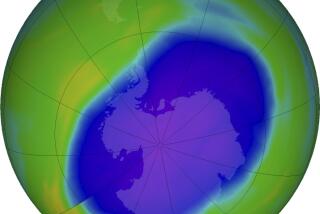Russia Faces New Threat--From Above
- Share via
NOVOSIBIRSK, Russia — In this land of melting permafrost and dwindling species, a new ecological threat is gathering strength over much of Russia.
Two giant holes have opened up this spring in the Earth’s protective ozone layer, exposing an area twice the size of Texas east of the Ural Mountains and a smaller but no less distressing gap over the densely populated northwestern region spanning Moscow, St. Petersburg and the now-independent Baltic states.
Scientists tracking the alarming new openings in the Earth’s shield against ultraviolet radiation say they are unsure of the causes of the breaches but acknowledge that decades of reckless development of Siberia during the Soviet era at least contributed to the problem.
“The human factor is no doubt responsible for the conditions leading to depletion of the ozone layer,” said Vladimir F. Zuyev, director of the Institute of Atmospheric Optics in Tomsk.
“But the truth of the matter is that we don’t really understand the mechanics of how geophysical and chemical substances are interacting with ozone, and until we do we cannot draw intelligent conclusions about what changes are needed in human behavior,” said the country’s chief expert on the ozone layer.
The new holes over Russia were first detected in early March by weather satellites.
Thinning of the ozone shield that enshrouds the Earth was first noticed over Antarctica in the early 1980s, and a corresponding hole over the North Pole has also been detected at times, say researchers at the Siberian branch of the Academy of Sciences here.
Western and Russian studies suggest that fluorocarbons from aerosol cans and Freon gas used in refrigeration are primary culprits in destroying 4% of the ozone layer over the past decade.
A 1992 study by the academy’s Siberian branch also tied the activity of major gas-producing enterprises in the Tyumen region to the sharp deterioration of ozone in the stratosphere.
But the scientists argue that natural phenomena appear to be equally influential.
For more than 10 years, Zuyev’s institute has measured the levels of ozone and other substances in atmospheric layers up to 35 miles above the Earth in vertical zones. The single most discernible influence on ozone quantities in that time, he said, was the June 1991 eruption of Mt. Pinatubo in the Philippines.
“We have to learn more about the chemical reactions that occur at different levels and how different substances interact,” Zuyev said.
Like others studying the atmosphere, he is perplexed by contradictory influences on weather in regions where ozone is diminishing.
Some Russian scientists, such as National Weather Service laboratory chief Grigory Kruchenitsky, argue that ozone itself can be harmful to human beings if present in the lower layers of the atmosphere.
Alexei Dmitriyev, another leading researcher at the Academy’s Institute of Geology, wrote in last month’s issue of Science in Siberia that ozone levels in the atmosphere surrounding other planets of the solar system have been increasing over the past decade and that the Earth too could soon see an infusion of the substance with unknown consequences.
*
The overarching message from Siberian scientists is that more research must be done to understand the vital ozone layer and that more international cooperation is needed to get that job done.
Echoing a lament that can be heard in the halls of academia across Russia, Yuri Shokin, acting director of the prestigious Siberian academy branch, notes that government funding for his research institutes has dropped to about 8% of its Soviet-era level.
While research on the ozone problem continues, Zuyev argues that it should be accelerated so scientists can guide industry in making the necessary changes to preserve one of the Earth’s natural defenses.
“If we continue to lose the ozone shield at this rate,” he warned, “within 200 years nothing will be able to live on this planet.”
Williams was recently on assignment in Novosibirsk.
(BEGIN TEXT OF INFOBOX / INFOGRAPHIC)
Holes in Russia’s Ozone Layer
* Ozone is a molecule of oxygen containing three oxygen atoms instead of the usual two. At low altitudes, it is considered a pollutant. Yet in the stratosphere, nine to 18 miles above the Earth, it has beneficial effects: It screens out harmful ultraviolet radiation while providing a layer of insulation that helps the planet retain warmth.
* Two giant holes have developed in the ozone layer over Russia recently. Scientists blame factors such as chlorofluorocarbons from aerosol cans and Freon gas used in refrigeration; major gas-producing industries; and natural phenomena such as volcanic eruptions.
More to Read
Sign up for Essential California
The most important California stories and recommendations in your inbox every morning.
You may occasionally receive promotional content from the Los Angeles Times.













